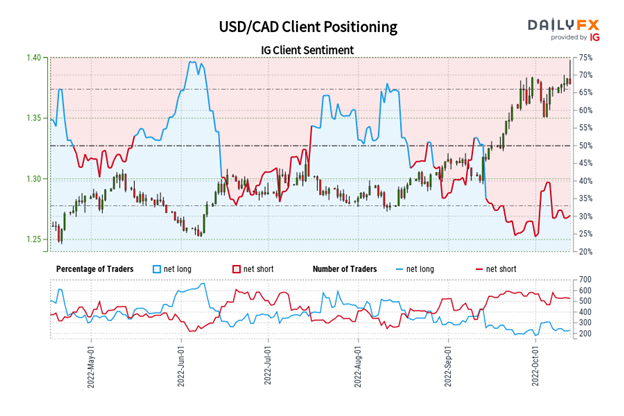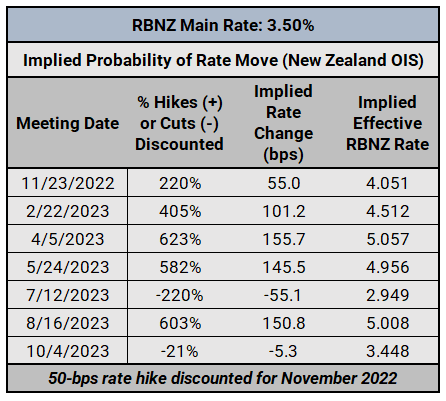Central Bank Watch Overview:
- The Bank of Canada is expected to raise rates by 50-bps when policymakers meet later this month.
- While the Reserve Bank of Australia and Reserve Bank of New Zealand won’t meet again until November, both central banks are forecast to raise rates by 50-bps next month.
- Retail trader positioning suggests that AUD/USD rates have a bearish bias, NZD/USD rates have a mixed bias, and USD/CAD rates have a bullish bias.
Rate Hike Path Slowing
In this edition of Central Bank Watch, we’re examining the rates markets around the Bank of Canada, Reserve Bank of Australia, and Reserve Bank of New Zealand. After raising rates aggressively over the course of 2022 – frontloading rate hikes, if you will – the three commodity currency central banks appear poised to slowdown their pace of monetary policy tightening moving forward. Relative to the Federal Reserve’s still-aggressive intentions, this change in perception has been a negative development for the Australian, Canadian, and New Zealand Dollars.
For more information on central banks, please visit the DailyFX Central Bank Release Calendar.
Recommended by Christopher Vecchio, CFA
Introduction to Forex News Trading
BOC Done Front-Loading
The Bank of Canada raised rates by 75-bps in September after a 100-bps rate hike in July, suggesting a climbdown in the their aggressive approach. Although comments in recent weeks have suggested that the BOC intends on remaining aggressive, rates markets don’t think the path of rate hikes moving forward will be nearly as aggressive as it was over the summer months.
Bank of Canada Interest Rate Expectations (October 13, 2022) (Table 1)
According to Canada overnight index swaps (OIS), rates markets are discounting a 24% chance of a 75-bps rate hike later this month (a 100% chance of a 25-bps rate hike, a 100% chance of a 50-bps rate hike, a 24% chance of a 75-bps rate hike), and are favoring a final 25-bps rate hike by the end of the year. Rates markets are estimating the BOC’s main rate to rise to 4.107% by the end of 2022.
IG Client Sentiment Index: USD/CAD Rate Forecast (October 13, 2022) (Chart 1)

USD/CAD: Retail trader data shows 27.87% of traders are net-long with the ratio of traders short to long at 2.59 to 1. The number of traders net-long is 26.61% lower than yesterday and 35.92% lower from last week, while the number of traders net-short is 8.54% lower than yesterday and 8.37% lower from last week.
We typically take a contrarian view to crowd sentiment, and the fact traders are net-short suggests USD/CAD prices may continue to rise.
Traders are further net-short than yesterday and last week, and the combination of current sentiment and recent changes gives us a stronger USD/CAD-bullish contrarian trading bias.
RBA Disappointment Weighing on Aussie
Recent comments by key Reserve Bank of Australia officials suggests that the central bank still has some ways to go in order to bring its main rate into neutral territory, the level as which monetary policy is neither expansionary nor contractionary. RBA Assistant Governor for Economics Luci Ellis remarks this week effectively pegged the neutral rate between 2.5% and 3.5%; currently, the RBA’s main rate is 2.6%. More tightening may be ahead, but it may come in more measured increments over the next few months.
Recommended by Christopher Vecchio, CFA
Get Your Free AUD Forecast
RESERVE BANK OF AUSTRALIA INTEREST RATE EXPECTATIONS (October 13, 2022) (TABLE 2)

According to Australia overnight index swaps (OIS), there is an 82% chance of a 25-bps rate hike in November and a 59% chance of a 25-bps rate hike in December. Rates markets are priced such that the RBA will bring its main rate to 2.997% by the end of 2022, which is a meaningful reduction from where markets were priced in early-September, when the main rate was expected to rise to 3.259% by the end of the year.
IG Client Sentiment Index: AUD/USD Rate Forecast (October 13, 2022) (Chart 2)

AUD/USD: Retail trader data shows 80.49% of traders are net-long with the ratio of traders long to short at 4.13 to 1. The number of traders net-long is 7.84% lower than yesterday and 1.35% higher from last week, while the number of traders net-short is 27.51% lower than yesterday and 6.14% lower from last week.
We typically take a contrarian view to crowd sentiment, and the fact traders are net-long suggests AUD/USD prices may continue to fall.
Traders are further net-long than yesterday and last week, and the combination of current sentiment and recent changes gives us a stronger AUD/USD-bearish contrarian trading bias.
Recommended by Christopher Vecchio, CFA
How to Trade AUD/USD
RBNZ on a Steadier Path
Unlike the BOC and the RBA, the Reserve Bank of New Zealand is poised to continue its relatively aggressive pace of rate hikes over the near-term time horizon (although still not as aggressive as the Fed). In recent weeks, RBNZ Deputy Governor Christian Hawkesby said that policymakers want to bring the main rate “comfortably above neutral” in order to help reduce inflation pressures (which stood at +7.3% y/y as of 2Q’22; 3Q’22 New Zealand inflation data is due out before the end of the month).
RESERVE BANK OF NEW ZEALAND INTEREST RATE EXPECTATIONS (October 13, 2022) (Table 3)

According to New Zealand overnight index swaps, there is a 20% chance that the RBNZ raises rates by 75-bps when they meet in November (a 100% chance of a 25-bps rate hike and a 100% chance of a 50-bps rate hike). Markets are now pricing the overnight cash rate (OCR) to rise to 4.051% by the end of this year, up from an expected 3.927% by the end of 2022 as discounted last month.
Recommended by Christopher Vecchio, CFA
Forex for Beginners
IG Client Sentiment Index: NZD/USD Rate Forecast (October 13, 2022) (Chart 3)

NZD/USD: Retail trader data shows 73.05% of traders are net-long with the ratio of traders long to short at 2.71 to 1. The number of traders net-long is 8.64% lower than yesterday and 11.35% lower from last week, while the number of traders net-short is 22.93% lower than yesterday and 9.02% lower from last week.
We typically take a contrarian view to crowd sentiment, and the fact traders are net-long suggests NZD/USD prices may continue to fall.
Positioning is more net-long than yesterday but less net-long from last week. The combination of current sentiment and recent changes gives us a further mixed NZD/USD trading bias.
Trade Smarter – Sign up for the DailyFX Newsletter
Receive timely and compelling market commentary from the DailyFX team
Subscribe to Newsletter
— Written by Christopher Vecchio, CFA, Senior Strategist


Be the first to comment